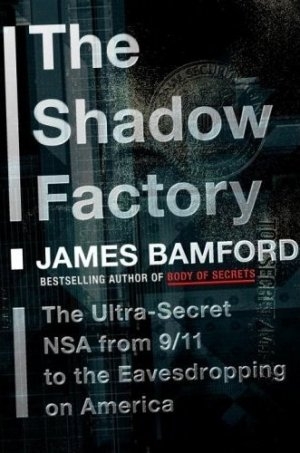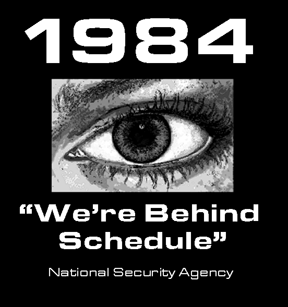
Following the attacks of September 11, 2001, the National Security Agency stepped up its efforts to collect intelligence domestically by filtering millions of phone conversations and e-mail messages. In his new book, The Shadow Factory: The Ultra-Secret NSA From 9/11 To The Eavesdropping On America, journalist James Bamford reveals that the ultra-secret agency has half a million people on its watch lists. Bamford has been writing about the inner workings of the NSA since his first book, The Shadow Factory: A Report On America’s Most Secret Agency, was published in 1982. He is also the author of Body Of Secrets: Anatomy Of The Ultra-Secret National Security Agency.
 EXCERPT: Michael Vincent Hayden stood at the window of his large corner office looking west through rimless glasses with rectangular lenses. Balding, with dark, graying hair cropped close on the sides, he had a broad globelike forehead, cheeks that were full and friendly, and a slight chin that quickly disappeared into his neck. At fifty-six, he was in good shape—stood as straight as a plumb line but carried a slight paunch that pressed tight against the buttons of his starched, powder-blue shirt. On each shoulder was a cloth epaulet with three silver stars, the rank of an air force lieutenant general.
EXCERPT: Michael Vincent Hayden stood at the window of his large corner office looking west through rimless glasses with rectangular lenses. Balding, with dark, graying hair cropped close on the sides, he had a broad globelike forehead, cheeks that were full and friendly, and a slight chin that quickly disappeared into his neck. At fifty-six, he was in good shape—stood as straight as a plumb line but carried a slight paunch that pressed tight against the buttons of his starched, powder-blue shirt. On each shoulder was a cloth epaulet with three silver stars, the rank of an air force lieutenant general.
Unrecognizable to most Americans, the man at the window was the nation’s top electronic spy, overseeing more analysts and operatives than anyone else in the country and possibly the planet. In addition to people, he controlled the largest collection of eavesdropping tools the world had ever known: constellations of billion-dollar satellites that could hear whispers on a cell phone from more than twenty-two thousand miles in space; moonlike listening posts around the globe with dozens of giant white orbs containing satellite dishes capable of pulling in tens of millions of phone calls, e-mail messages, and faxes an hour; and, to sort it all out, the largest collection of supercomputers on earth. In addition, he controlled the agency’s own secret military force, the little-known Central Security Service, with its fleets of ships, submarines, and aircraft that quietly vacuum the world for telltale voices and data.
The vast and mysterious city stretched out below Hayden was the largest, most powerful, and most intrusive eavesdropping machine ever created. Made up of tens of thousands of people, more than fifty buildings, dozens of receiving antennas, and the planet’s most powerful number-crunching supercomputers, it had one overriding goal: access. Access to billions of private hard-line, cell, and wireless telephone conversations; text, e-mail, and instant Internet messages; Web-page histories, faxes, and computer hard drives. Access to any signal or device that might  contain information in any form regardless of protection—firewalls, encryption, or passwords. Never before in history had a single person controlled so much secret power to pry into so many private lives.
contain information in any form regardless of protection—firewalls, encryption, or passwords. Never before in history had a single person controlled so much secret power to pry into so many private lives.
The NSA was once a backwater agency whose director had to fight to sit at the same table with the CIA chief, but by the time Hayden arrived it had become the largest, most expensive, and most technologically advanced spy organization on the planet. Supplying nearly 80 percent of all intelligence to the rest of government, it needed an entire city to house it—a city that, if incorporated, would be one of the largest municipalities in the state of Maryland. At the same time, it remained nearly as dark and mysterious as when Harry Truman secretly created it, without the approval—or even knowledge—of Congress, nearly half a century earlier. To those who worked there, NSA still stood for No Such Agency and Never Say Anything. To those on the outside it was virtually invisible, hidden from the world behind a labyrinth of barbed wire and electrified fences, massive boulders, motion detectors, hydraulic antitruck devices, cement barriers, attack dogs, and submachine gun-toting commandos in black ninja outfits nicknamed “Men in Black.” MORE
 RADIO TIMES
RADIO TIMES
Hour 1
Our guest is DEXTER FILKINS, Foreign Correspondent for The New York Times. He has covered the wars in Iraq and Afghanistan since 2001. His new book “The Forever War” tells about the realities on the ground of the stories he covered. Filkins was a finalist for a Pulitzer Prize, winner of George Polk Award and two Overseas Press Club awards. Listen to this show via Real Audio | mp3
Hour 2
While we are primarily focused on the $700 billion for the government financial bailout, a Fiscal Wake-Up Tour reminds us that we also have $9 trillion of national debt to pay for. Three members of the Tour join us with their perspectives on how the United States needs to be more fiscally responsible. ROBERT BIXBY is Executive Director of The Concord Coalition. ALICE RIVLIN is Director of the Greater Washington Research Program at The Brookings Institution and was a vice chair of the Federal Reserve Board. STUART BUTLER is Vice President for Domestic and Economic Policy Studies at the Heritage Foundation. Listen to this show via Real Audio | mp3
Looked at one way, the current flailing economy is a victim of invention—Wall Street invention. Investors and banks and brokers created all sorts of stuff the world would’ve been better off without. In the aftermath, Democrats have blamed Republicans for the mess, and, naturally, Republicans have blamed Democrats. Ira talks to Charles Duhigg, whose been covering the subprime mortgage crisis for The New York Times, to find out who we should really be mad at. ALSO, to deal with the financial crisis, our own government has also had to reinvent itself, with questionable consequences. This American Life producer Alex Blumberg and NPR’s financial reporter Adam Davidson talk to Brad Setser, an economist at the Council on Foreign Relations who used to work at the U.S. Treasury. Together they explain what happens when the government reinvents itself as a bank—and not necessarily a successful bank. Alex and Adam are part of an NPR’s Planet Money project.

